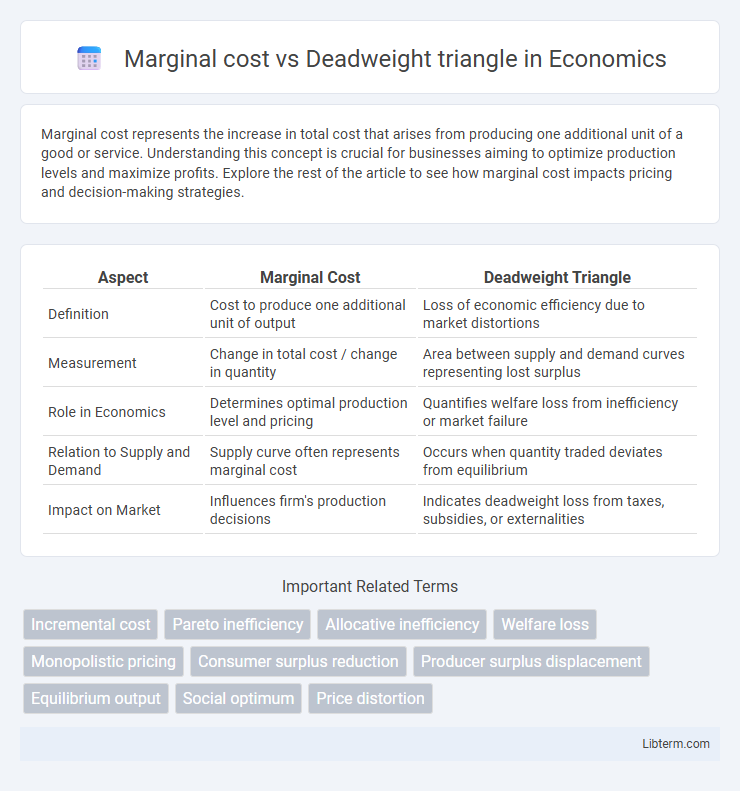Marginal cost represents the increase in total cost that arises from producing one additional unit of a good or service. Understanding this concept is crucial for businesses aiming to optimize production levels and maximize profits. Explore the rest of the article to see how marginal cost impacts pricing and decision-making strategies.
Table of Comparison
| Aspect | Marginal Cost | Deadweight Triangle |
|---|---|---|
| Definition | Cost to produce one additional unit of output | Loss of economic efficiency due to market distortions |
| Measurement | Change in total cost / change in quantity | Area between supply and demand curves representing lost surplus |
| Role in Economics | Determines optimal production level and pricing | Quantifies welfare loss from inefficiency or market failure |
| Relation to Supply and Demand | Supply curve often represents marginal cost | Occurs when quantity traded deviates from equilibrium |
| Impact on Market | Influences firm's production decisions | Indicates deadweight loss from taxes, subsidies, or externalities |
Introduction to Marginal Cost and Deadweight Triangle
Marginal cost represents the additional expense of producing one more unit of a good or service, playing a crucial role in optimal resource allocation and pricing decisions. The deadweight triangle, also known as the deadweight loss, illustrates the loss of economic efficiency when market equilibrium is disrupted by factors like taxes, subsidies, or price controls. Understanding the interaction between marginal cost and the deadweight triangle helps economists evaluate the social costs of market interventions and identify inefficient outcomes.
Defining Marginal Cost in Economics
Marginal cost in economics refers to the additional expense incurred from producing one more unit of a good or service, crucial for optimizing production decisions. It represents the change in total cost divided by the change in output quantity, influencing pricing strategies and efficiency analysis. Understanding marginal cost is essential for addressing the deadweight loss triangle, as discrepancies between marginal cost and price can lead to market inefficiencies and welfare losses.
Understanding the Deadweight Triangle
The deadweight triangle represents the loss of economic efficiency when marginal cost deviates from the market price, causing either overproduction or underproduction. It arises because the marginal cost curve intersects the marginal benefit curve at a point that is no longer optimal due to externalities or market interventions. Understanding the deadweight triangle helps economists quantify welfare loss and design policies to realign marginal costs with social costs or benefits.
Origins of the Deadweight Triangle in Market Structures
The deadweight triangle originates from the inefficiencies created when marginal cost diverges from marginal benefit in imperfect market structures such as monopolies or oligopolies. This welfare loss arises because output is restricted below the socially optimal level where price equals marginal cost. The size and shape of the deadweight triangle reflect the extent of market distortion caused by pricing above marginal cost, leading to lost consumer and producer surplus.
Graphical Representation: Marginal Cost vs Deadweight Triangle
The graphical representation of marginal cost typically shows an upward-sloping curve reflecting increasing costs with additional production, while the deadweight triangle appears as a shaded area between supply and demand curves indicating the loss of economic efficiency due to market distortions like taxes or monopolies. Marginal cost curves intersect with demand or marginal revenue curves at equilibrium output, whereas the deadweight loss triangle highlights the gap between socially optimal and actual production levels. This visualization clarifies the relationship between production costs and welfare losses, emphasizing how deviations from marginal cost pricing generate inefficiencies quantified by the deadweight triangle.
Causes of Deadweight Loss: Monopoly and Market Distortions
Deadweight loss arises in monopolies when marginal cost is lower than the price charged, leading to restricted output and inefficient resource allocation. Market distortions such as taxes, subsidies, and price controls further widen the deadweight triangle by causing supply and demand mismatches. These inefficiencies reduce total surplus by preventing mutually beneficial trades between consumers and producers.
Marginal Cost Pricing and Economic Efficiency
Marginal cost pricing involves setting the price equal to the marginal cost of production, ensuring that resources are allocated efficiently by producing the optimal quantity of goods. The deadweight triangle represents the loss of economic efficiency when prices deviate from marginal cost, leading to either underproduction or overproduction and resulting in welfare losses. Aligning price with marginal cost eliminates the deadweight triangle, maximizing social surplus and achieving economic efficiency.
Real-World Examples: Marginal Cost vs Deadweight Loss
Marginal cost represents the additional expense of producing one more unit of a good, directly influencing pricing and supply decisions in markets. Deadweight loss occurs when market inefficiencies, such as taxes or monopolies, cause production or consumption levels to deviate from the socially optimal point, creating lost economic value. Real-world examples include a monopolist producing fewer units at higher marginal costs, leading to deadweight loss by restricting output below the competitive equilibrium, and taxes raising marginal costs which reduce trade volume and generate inefficiency in markets like tobacco or gasoline.
Policy Implications and Regulatory Considerations
Understanding the relationship between marginal cost and the deadweight loss triangle is crucial for designing effective economic policies and regulatory frameworks. When marginal cost pricing is enforced, allocative efficiency improves by minimizing the deadweight loss associated with market distortions, such as monopoly pricing or externalities. Regulatory bodies must balance the benefits of marginal cost pricing against potential financial sustainability challenges, especially in industries with high fixed costs or natural monopolies.
Conclusion: Minimizing Deadweight Loss through Marginal Cost Analysis
Minimizing deadweight loss requires aligning production with the marginal cost, ensuring the quantity of goods produced reflects the true social cost of resources used. Deadweight triangles represent the efficiency loss from producing too little or too much relative to marginal cost pricing. Effective marginal cost analysis optimizes resource allocation, reducing welfare losses and maximizing economic efficiency.
Marginal cost Infographic

 libterm.com
libterm.com